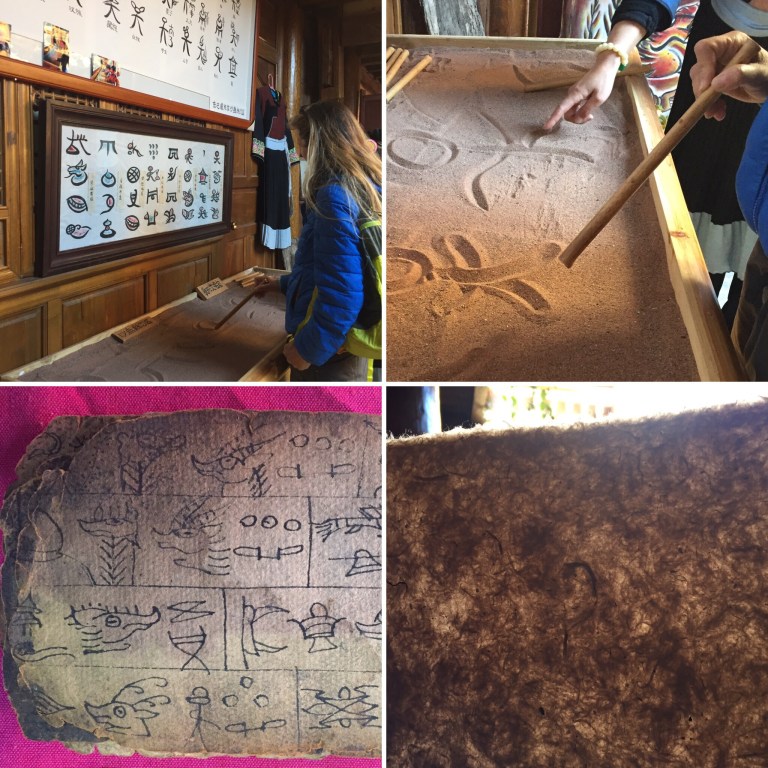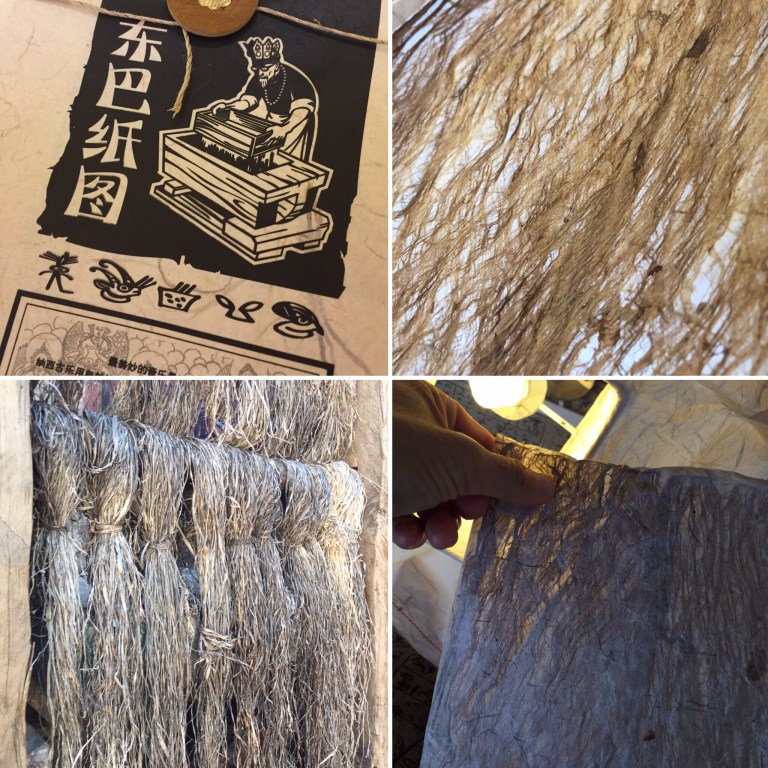Lijiang is nestled in a small plateau 2500 metres above sea level and has been a well visited town for years. Peter Goullart’s book ‘Forgotten Kingdom’ (which inspired James Hilton’s novel ‘Lost Horizon’ turned by Frank Capra into a movie) depicts the town and it’s cultural aspects expressively. We were taken aback by the commercialisation and amount of national tourists, all buying silver, traditional souvenirs or gorging in one of the mainly eateries. We came here hoping to find information on both dongba paper and the fascinating pictogram language developed by the naxi culture and written by dongba priests.
Our first visit was to the hall of ‘Naxi hieroglyphics painting’, (hieroglyphics or pictograms?). We were Greeted by a friendly women in vibrant traditional dress she pointed to examples of pictograms and several manuscripts all painted on dongba paper. Securely under glass were several manuscripts dated over 1000-800 years old to more modern examples. We were getting excited to see these as many manuscripts where destroyed in the cultural revolution (1966-1976). She followed us around the small hall where more contemporary examples of pictograms where being interpreted. There was a small sand table and chart prompting you to trace out your own pictorials. We flicked through her reference books and wanted to purchase one but these were not for sale. We left happy to have our first introduction to this language system but she wanted to gift us the book as it was hers. We did not want to take her only copy and left happy to have been offered such a generous gift but that we had not taken it. We saw her several times after and her warm smile and giggles greeted us (I’m sure it translated oh you two again).

Nestled within the over commercialised alleyways and waterways of the old town were several Donga paper shops promoting and selling paper made products. We were in joy we were going to find out more for sure. However, getting information from locals (people working in the paper shops) has been looking for a needle in a haystack. Language is obviously a main hurdle but even when we found an English speaker it was fruitless. “Where is the paper made?”- Lijiang, but where in Lijiang? Maybe in Shangri-la (300km away). One shop assistant indicated there was a workshop in the old town.

The following day we wondered to the handicraft area and found another dongba shop. In the corner where several papermaking tools and freshly made paper. Ok we are getting excited now. The shop assistant wearing a yak like waistcoat indicated he would demonstrate outside (performance wear). This was a show piece demo to bring in visitors to the shop. The man grabbed his hat adorned with exotic plumage and set about demonstrating dongba paper making. Like many paper making processes the stages are similar but here the beater was possibly created for small patches. It was a long hollow wooden tube with a wooden plunger (see pics). The pulp (pre made) was placed with several scoops of water into the barrel and a beating motion began (with me helping). Once the pulp was beaten, it was poured into the frame, which was floating in a larger stone water trough. The difference here from a European deckle/frame was there was no mesh. In place of the mesh was a removalable thin wooden mat (similar to sushi roll mat). Once the pulp had been positioned to give an even amount of pulp to cover the surface of the frame this was gently lifted out of the water and rested on the edge of the trough for excess water to drain. The removable mat was lifted from the frame and placed onto the wooden board (angled). Pressure was placed over the mat and the mat was pealed off the paper which remained on the board. The next stage was to remove the excess water and this was done by a heavy pin roller. An absorbent cloth was placed on the pulped paper and with pressure the roller was used to remove the water. The last stage was to place the paper in the sun to dry.
The paper has a longevity for a thousand years due to its properties. Two different barks of local plants are used as the main paper pulp which are grown at an altitude of 1300metres. Similar to the mulberry paper in Samarkand it is resistant to insect infestation. Dongba paper has been used by Buddhist monks for scriptures and Dongba priests to communicate their pictorial language system.

The demo gave us a little introduction into dongba technique and the materials in the shop gave detailed historical papermaking processes and factual info but we still couldn’t find out where the products where made. The man said the paper is made in Shangri-la, “where in Shangri-la?” , no reply! We have later read that the Dongba paper shops (brand and patent) have been borrowed and interpreted from the Dongba culture.
Our next port of call was the Dongba cultural museum within the Black Dragon pool park. Beautiful situated this unvisited centre was excellent with well written English translations and a wide range of naxi/dongba cultural references. We were blown away at the amount of manuscripts on display from depicting rituals, customs and donga heritage. There was also a display detailing the Dongba papermaking process, which correlated to the demo we were shown. The display also highlighted the amount of manuscripts abroad. In fact there seems to be more research materials and publications written in the USA and Europe. Thankfully many manuscripts where preserved before the destruction of cultural heritage (cultural revolution)
The pictograms have a sensibility to them based on human form, movement and rooted in nature. Beautifully rendered with a free hand and a fluid narrative, even if you couldn’t understand much without a guide. Leaving the centre we were content but still the question of where is the paper produced today.



We locked the bikes up in the hostel and headed north by mini bus to Shangri la (4hrs away at 3300 metres above sea level), in search of the paper. We are heading here anyway to visit the monasteries and intake Tibetan air once more. It was good to leave the bikes as both nursing colds and we were to only backtrack to Lijiang. Unfortunately the paper search was fruitless. No one knew anything, even when a lovely women in the cafe phoned around her naxi colleagues no one was sure. We were told in a village about 150km away there maybe someone, but you’d need to hire a car and driver. It was too uncertain and both not feeling 100% we allowed that one to get away. We were left reading a great article on it (below link). We have found that many Chinese people either are protective about information, unwillingly or really do not know.
After couple days we returned to lijaing to pass the smiley naxi lady in the hall of hieroglyphics and we finally waved goodbye for the last time but not to our colds!
Short video clips of the ‘Dongba (interpretation) papermaking demo in Lijiang:
All photography by Jack Blake & Barbara Salvadori 2017©
Related links:
http://www.globaltimes.cn/special/2010-08/568532.html
http://wap.chinadaily.com.cn/2015-10/23/content_22264758.htm



Such an interesting read ( as usual ) !
Great information and beautiful pictures . Get well soon both of you .
Keep safe x
LikeLike
800-1,000yrs. Wow will there be a picture of you two that future cyclist will wonder at. What a great time your having, apart from the colds. Leontine xx
LikeLike
Ahhh this post was fascinating! And to see you in pictures and a bonus video! Your writing is so vivid and enticing.
This one especially made me wish I could magically whisk my way over and join you. Sorry about your colds, though. Hope you’re feeling better. HUGE admiration and hugs, Deb xox
PS Alex and Lars arrived in Australia for a visit yesterday….the day marriage equality was finally made law! (very late in the day but still….)Their marriage was officially recognised by this govt at midnight last night.
LikeLiked by 1 person
Hi D, yes we saw the news and the singing in parliament- fantastic news. Say hi to Alex & Lars from us. I’m much better now and back cycling which feels good. Thanks for your comments on the blog too. Xx
LikeLike
Wonderful “Reportage”on paper making ! You are just amazing.
As an engraving artist, I just love paper and admire people who are still making it.
Would you please tell me how I can find Dongba paper ?
Best regards
LikeLike
Really sorry for such a late reply I haven’t been on our site for some time. Im really not sure how you can get Dongba paper outside of China. Perhaps they have a distributor elsewhere. If I find any info I will contact you.
Thank you for your message
LikeLike
Any other place traditional papermaking on the Paper Road? Hotan, China, have you visited?
LikeLike